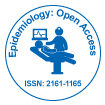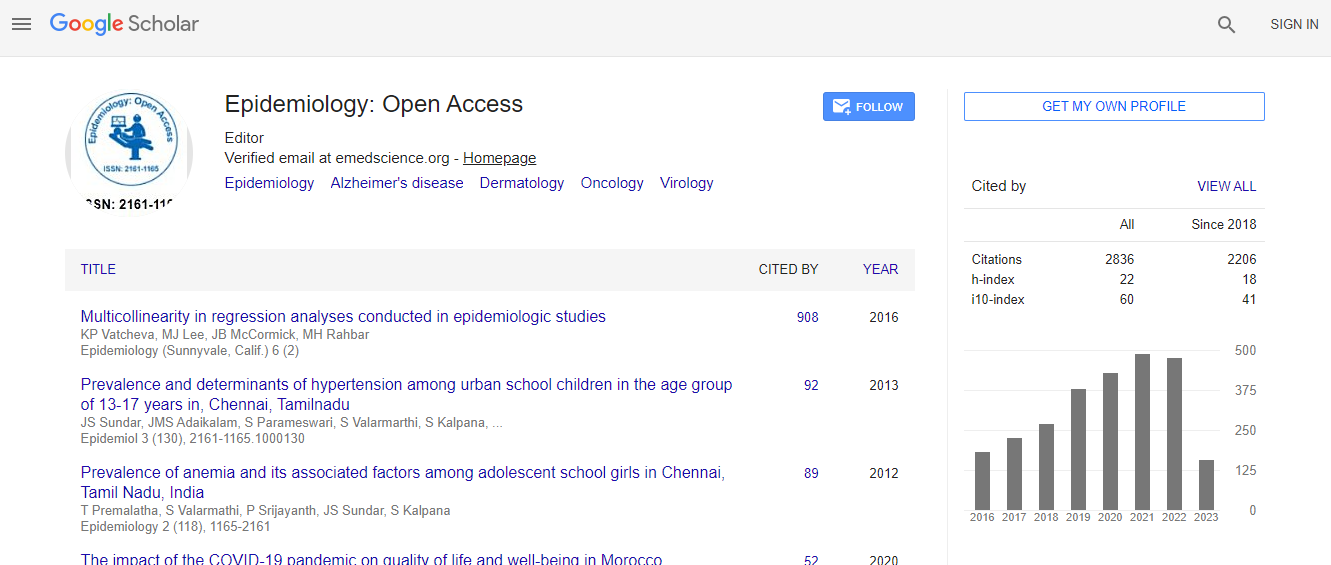Our Group organises 3000+ Global Conferenceseries Events every year across USA, Europe & Asia with support from 1000 more scientific Societies and Publishes 700+ Open Access Journals which contains over 50000 eminent personalities, reputed scientists as editorial board members.
Open Access Journals gaining more Readers and Citations
700 Journals and 15,000,000 Readers Each Journal is getting 25,000+ Readers
Google Scholar citation report
Citations : 3864
Epidemiology: Open Access received 3864 citations as per Google Scholar report
Epidemiology: Open Access peer review process verified at publons
Indexed In
- Index Copernicus
- Google Scholar
- Sherpa Romeo
- Genamics JournalSeek
- SafetyLit
- Access to Global Online Research in Agriculture (AGORA)
- Centre for Agriculture and Biosciences International (CABI)
- RefSeek
- Hamdard University
- EBSCO A-Z
- OCLC- WorldCat
- CABI full text
- Cab direct
- Publons
- Geneva Foundation for Medical Education and Research
- Euro Pub
- ICMJE
Useful Links
Recommended Journals
Related Subjects
Share This Page
Federal Research Action Plan on recycled tire crumb used on playing fields and playgrounds
8th International Conference on Epidemiology & Public Health
Angela Ragin-Wilson, Elizabeth Irvin-Barnwell, Kent Thomas and Annette Guiseppi-Elie
Agency for Toxic Substances and Disease Registry in Atlanta, GeorgiaUnited States Environmental Protection Agency, USA
ScientificTracks Abstracts: Epidemiology (Sunnyvale)
Abstract
Recently, concerns have been raised by the public about the use of recycled tire crumb rubber infill at synthetic turf fields in the United States. While the majority of studies identified numerous chemical compounds within the crumb rubber, including volatile organic compounds (VOCs), semi-volatile organic compounds (SVOCs), and metals, the measured concentrations were generally low. To date, the studies have not shown elevated health risks from use of and contact with synthetic turf. However, the studies are limited and do not comprehensively address the concerns about the potential health risks associated with exposure to chemicals in the crumb rubber infill. To help address concerns raised by the public, the Centers for Disease Control and Prevention/Agency for Toxic Substances and Disease Registry (CDC/ATSDR) and the U.S. Environmental Protection Agency (EPA), in collaboration with the Consumer Product Safety Commission (CPSC), launched a multi-agency research effort in February 2016. The Federal Research Action Plan on Recycled Tire Crumb Used on Playing Fields and Playgrounds (FRAP) focuses on understanding potential human exposure to chemicals in recycled tire crumb rubber used in synthetic fields, which includes characterizing the chemicals in recycled tire crumb rubber and identifying the ways in which people may be exposed to these chemicals based on their activities on synthetic turf fields. Specific activities outlines in the FRAP include 1) conduct a literature review and data gaps analysis, 2) identify and characterize chemical compounds found in tire crumb used in artificial turf fields, and 3) characterize exposures, or how people are exposed to these chemical compounds based on their activities on the fields. This presentation will provide an overview of the activities led by EPA and CDC/ATSDR on the multi-agency research initiative. Recent Publications 1. Gomes J, Mota H, Bordado J, et al. Toxicological assessment of coated versus uncoated rubber granulates obtained from used tires for use in sports facilities. 2010. J Air Waste Manage Assoc. 60: 741-6. 2. Bocca B, Forte G, Petricci F, Constantini S, Izzo P. Metals contained and leached from rubber granulates used in synthetic turf areas. 2009. Sci Total Environ. 407: 2183-90. 3. Ginsberg G, Toal B, Kurland T. Human health risk assessment of synthetic turf fields based upon investigation of five fields in Connecticut. 2011. J Toxicol Environ Health A. 74: 1150-74. 4. Simcox NJ, Bracker A, Ginsberg G, Toal B, Golembiewski B, Kurland T, Hedman C. Synthetic turf field investigation in Connecticut. 2011. J Toxicol Environ Health A. 74: 1133-49. 5. Kim S, Yang JY, Kim HH, Yeo IY, Shin DC, Lim YW. Health risk assessment of lead ingestion exposure by particle sizes in crumb rubber on artificial turf considering bioavailability. 2012. Environ Health Toxicol. 27: e2012005. 6. Marsili L, Coppola D, Bianchi N, Maltese S, Bianchi M, Fossi MC. Release of polycyclic aromatic hydrocarbons and heavy metals from rubber crumb in synthetic turf fields: preliminary hazard assessment for athletes. 2014. J Environ Anal Toxicol. 5: 1-8.Biography
Angela Ragin-Wilson is a Chief of the Environmental Epidemiology Branch in the Division of Toxicology and Human Health Sciences at the Agency for Toxic Substances and Disease Registry/National Center for Environmental Health, Centers for Disease Control and Prevention, she serves as an expert technical advisor on a wide range of environmental and public health issues. She manages several programs and projects including the Navajo Prospective Birth Cohort Study and the Federal Research Action Plan on Recycled Tire Crumb Used on Playing Fields and Playgrounds. During her federal career, she has held several scientific and leadership positions and worked on diverse projects. From 2003-2008, she was a team lead in Division of Laboratory Sciences, Organic Analytical Toxicology Branch. In this role, she developed cutting-edge innovative laboratory methods for improving, and increasing the timeliness and accuracy of domestic and international biomonitoring studies.
E-mail: ARagin@cdc.gov

 Spanish
Spanish  Chinese
Chinese  Russian
Russian  German
German  French
French  Japanese
Japanese  Portuguese
Portuguese  Hindi
Hindi 

